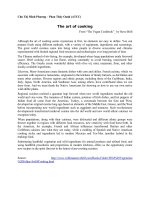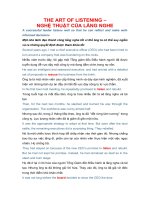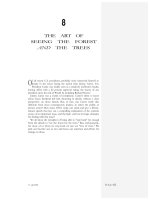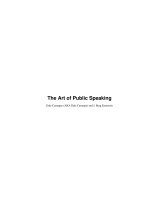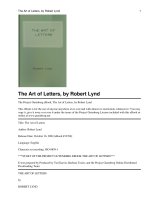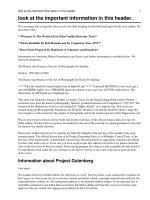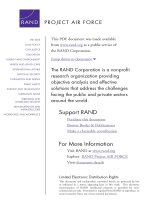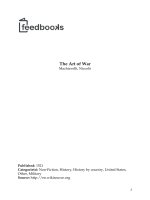The art fashion draping parte 4
Bạn đang xem bản rút gọn của tài liệu. Xem và tải ngay bản đầy đủ của tài liệu tại đây (16.79 MB, 116 trang )
Chapter Seventeen
Dressed
Obsectives
By studying the various draping steps in this chapter, the * Explore and define style lines and silhouettes over
designer should be able to accomplish the following:
the bust, hip, and waist to create folds, darts,
* Manipulate the fabric and learn how to mold and pleats, and/or fullness.
shape the fabric on the dress form.
* Develop creativity and stimulate a variety of ideas.
* Maintain a smooth and easy-flowing design that
* Enhance draping skills in handling pliable fabric to
does not overwork a piece of fabric.
define a design and judge what designs are flatter-
ing to a particular figure.
Bias-cut Slip Dress
(— \
Because of the inherent stretchability designers, you should understand This dress is cut on the bias of a soft
of bias fabric, designers such as fabric, which results in a closer fit
Donna Karan used it to create new that if bias-cut garments are draped that stretches and conforms to the
dress styles for the 1990s. The bias- improperly, they will hug the body
cut slip dress has won approval in and every imperfection will be movements of the body.
the retail market at all levels. It can emphasized. The slip dress is an alternative to }
be slipped on over the head, which
makes it easy to get into and out of, The bias cut slip dress is a sleeve- the bodysuit. It may be worn alone _
and it is comfortable to wear. As less styled dress with a neckline
beginning above the bust. It is held or with a soft cardigan, a tailored |
in place with thin spaghetti straps. blazer, or leggings.
Advanced Design Variations
278
[Bias-cut Slip Dress — Preparing the Fabric
For the length and width
‘of the dress, measure and cut
perfect 45-inch squares.
Drawa true bias line diago-
‘nally across the pieces of fabric.
Dresses
a4 0
Bias-cut Slip Dress —Draping Steps
Prepare the dress form.
Place pins on the dress form at the
desired bustline. Remove the bust
level tape (bra) from the dress form.
SL 2
0 Pin the bias line of the fab-
ric to the center front position
of the dress form. The fabric piece
should extend at least 3 inches
above the styled bustline.
Advanced Design Variations
260
Bias-cut Slip Dress —Draping Steps
0 Smooth, clip, and pin the 6 Clip, smooth, and fit the
side seam down to the
fabric across the neckline
waistline. As the side seam is
style line. Approximately 2 inches being fitted, a second slight flare
will be created from the hipline in
from center front, clip the fabric the middle of the princess panel.
from the top edge down to the Drape in the remaining of the side
neckline style line. Pin the neck-
line style line seam at the clip. seam below the waistline.
@ Create a slight flowing 0 Mark all key areas of the
flare below the bust. dress form of the center front
panel.
Because the fabric is on the bias
and is soft, the bust area can be Front Bustline Style Line Seam
molded into a close-to-body fit. As
this bias drape is molded over the Waistline at Side Seam Place a
bustline, a slight flare will be cre- waistline notch.
ated below the bust that extends
Side Seam Lightly mark.
to the hemline.
Hem Follow the bottom of the
0 Smooth, clip, and pin dress form or a rung.
approximately 2 inches
DO NOT REMOVE THE DRAPE
from the first clip of the neck- FROM THE DRESS FORM
line style line. Mold and smooth
the remainder of the bust area.
Continue to smooth the fabric
across the neckline style line seam,
over the bust, and toward the side
seam.
7) Pin the bias line of the fab-
ric to the center back position
of the dress form. The fabric piece
should extend at least 3 inches
above the styled bustline.
Dresses
28]
Bias-cut Slip Dress —Draping Steps
0 Smooth, clip, and pin the 0 Smooth, clip, and pin Q Drape and measure the
fabric across the back neck- approximately 2 inches amount of spaghetti strap-
line style line. Approximately 2 from the first clip of the back ping needed for this design. Add
inches from center back, clip the neckline style line. Mold and an inch for seam allowance.
fabric from the top edge down to smooth the remainder of the back
the back neckline style line. Pin the neckline area. Continue to smooth
neckline style line seam at the clip.
the fabric across the neckline style
9 Create a slight flowing
flare below the back neck- line seam toward the side seam.
line style line. As this bias drape 0 Clip, smooth, and fit the
is being molded over the back side seam down to the
neckline style line, a slight flare
will be created at the princess waistline. As the back side seam
seam that extends to the hemline. is being draped, pin it to the front
side seam. As the side seam is
being fitted, a second slight flare
will be created from the hipline in
the middle of the princess panel.
Drape in the remaining of the side
seam below the waistline.
Ô Match the back side seam
to the front side seam, pin-
ning and fitting the dress until the
desired side seam shape is
achieved.
0 Mark all key areas of the
dress form of the center front
panel.
Back Bustline Style Line Seam
Waistline at Side Seam Place a
waistline notch.
Side Seam Lightly mark.
Hem Follow the bottom of the
dress form or a rung.
Advanced Design Varéations
012
Me Slip Dress —Draping Steps
True up the front and back
dress. Remove the fabric
drape from the dress form. True up
ll seams, add seam allowances,
\d trim excess fabric. Pin the
drape to the back drape.
Irn the finished drape to the
form and check for accuracy,
and balance.
Dresses
283
“Sculptured” Dress
A “sculptured” dress has excess fab- bust and creates a smooth molded
ric tucks or pleats around the bust effect in the waist area of the dress.
area that radiate from a shaped These multiple folds will hug, wrap,
motif and blend to nothing at the and drape the body to produce a
side seam. The tucks or pleats distrib- sultry, sexy, and provocative dress.
ute and shape the fabric around the
0 Measure, along the straight
of grain, 60 inches to 88
inches, which is the length for the
front and back. Snip and tear the
fabric at this length.
Advanced Design Variations
284
“Sculptured” Dress — Preparing the Fabric
Back Front
Ệ Measure, along the cross- 60”
grain, the width for the
front and back.
a. For the front drape, it will be
Necessary to use the full width of
the fabric goods.
|b. For the back drape, measure
from the center back to the side
| seam, and add 8 inches. Snip and
‘tear the fabric at this width. The
Measurement will be at least 18
inches.
S=———†8”——> *————— Width ofFabric ~———————*
Draw the grainline for the
front in the middle of the fabric
lọce.
Draw the grainline for the
back panel 10 inches from the
edge.
Draw the crossgrain for the
back panel 9 inches from the top
of the fabric.
+<—— Width of Fabric —___—_—_
Dresses
015
“Sculptured” Dress —Front Draping Steps
Prepare the dress form. 0 Design and drape in the 0 Place the grainline for the
front dress.
Refer to the garment design and desired motif (with all neces-
note on the dress form the area of a, Position the grainline on the
sary seam allowances). Place this center of the princess panel on the
emphasis from which the drapes dress form. Pin this grainline from
motif on the dress form. (This area the bottom of the dress form up
will radiate. to the hipline with at least three
was previously noted.) pins.
b. Allow all excess fabric to fall
over the shoulder and the top of
the dress form while draping the
lower area of the design.
c. Drape and pin the fabric
across center front of the dress
form. Keep the grain of the fabric
parallel to center front. Secure
pins on the center front position
with a couple more pins.
Advanced Design Variations
286
[(Seulpturea” Dreas—Front Draping Steps
Pleat Pleat
Continue to
Pin & Clip
Trim, clip, and the create 0 Create the second pleat. @ Continue to pin, clip, and
first pleat.
a. Smooth the fabric up on the place the remainder of the
Clip the fabric approximately 2 pleats. Pin and clip the side seam
inches from the side seam of the side seam at the point from which
dress form. Clip fabric up from the the second pleat will radiate. about every inch or so. At each
bottom edge to where the lowest
b. Place a pin on the side seam at pinning and clipping, fold a new
at will radiate. this point.
to this drape, each radiating from the
Place a pin on the side seam at €. Clip into the side seam design motif. Also, continue to clip
and trim the side seam past the
point from where the lowest pin.
waistline.
leat will radiate.
d. Fold the second drape from the
€, Clip into the side seam to this design motif to nothing at the sec-
ond pin on the side seam.
‘d. Fold the first drape from the
In motif to nothing at the
pinned side seam.
The grainline will start to
angle toward the center front and
become more exaggerated in this
direction as the pleats are contin-
ued, Also, this first pleat is the
ost difficult of the pleating
ocess. Be patient.
Dresses
287
“Sculptured” Dress —Eront Draping Steps
" Trim parallel
to the
Grainline
into the
motif
6 Smooth the fabric upward 0 Create pleats at the design 0 Trim neckline area. Leave at
least 2 inches of excess fabric
in a clockwise direction, flat motif.
for possible neckline shape
over the armplate and shoulder, a. Use the excess fabric that
after the side seam area has been falls below the bustline. Working changes and seam allowances,
draped. Be careful not to stretch left to right, pin and place pleats
the fabric. 0 Pin and drape in the
at the design motif stitchline. desired neckline. Trim excess
ue Trim away the excess fabric
Allow each pleat to fall over the fabric at the neckline, shoulder,
that is falling toward the back bust area and radiate to nothing and side seam.
of the dress form, leaving approxi- over the bust. Ô Mark key areas of the dress
mately a 4-inch excess. Recheck the form to the fabric.
shoulder draped area. b. Trim excess fabric at the
Shoulder
6 Clip the fabric to the center design motif (one pleat at a Desired Front Armhole Shape
of the design motif from the time) as pleats are pinned and Desired Front Neckline Shape
edge of the fabric near the grain- draped in place. Side Seam
line. Motif (Stitchline) and Pleats
8 Trim the fabric around the
design motif area that has
been draped. Leave enough fabric
for seam allowances and the upper
bodice drape.
Advanced Design Variations
288
“Sculptured” Dress —Front Draping Steps
Q Create more fullness in the
center front. Clip, pin, and
allow excess fabric to fall from
nothing at the lowest section of
the design motif and to flow as
extra fullness to the hem/center
front area. Transfer and draw in a
new center front position of the
dress form to the fabric drape.
NOTE: The skirt area will cascade
easier if a slight pulling up of the
fabric at the design motif is used.
0 Place the back crossgrain at
the shoulder blade level.
Pin in place.
é Place the back straight
grainline in the center of
the back princess panel. Pin in
place. Pin center back near the
hem on the dress form rung.
Dresses
289
"Seulptured” Dress — Back Draping Steps
Clip
9 Trim, clip, and drape in the @ Clip the waistline area at 0 Smooth, shape. and pina
back neckline. center back and the side fitted side seam. Finish drap-
seam. Also, clip once above and
0 Drape the back shoulder ing the side seam by pinning the
area. Smooth the fabric over once below the waist area at the front side seam to the back side
side seam and center back. seam.
and past the shoulder seam and
drape in the shoulder area. Ô Smooth, shape, and pin a
fitted center back seam.
Approximately 3/4 of an inch will
be smoothed out at the center
back/waist area. The waist area will
extend up and drape to nothing at
the crossgrain line and down to
nothing at the hipline.
Advanced Design Variations
090
*Seulptured” Dress —Back Draping Steps
Mark all key areas of the 9 True up motif, front and back
dress form to the fabric. dress. Remove the fabric drape
Desired Back Neckline Shape from the dress form. True up all
‘Shoulder Seam match front seams, add seam allowances, and
trim excess fabric. Pin the front
‘shoulder seam. Shape drape to the back drape.
Desired Armhole
‘Side Seam Return the finished drape to the
dress form and check for accuracy,
fit, and balance.
Dresses
0 3]
Bustier
The bustier is a form-fitting strapless center back/zipper or an elasticized
princess bodice that fits snugly
around the rib cage. A traditional back area.
bustier foundation garment has a
low-cut front and back neckline. Special boning and sewing tech-
Front princess seams are always niques help support the foundation
used to create and support an extra section of this classical bodice. A
tight fit at the princess seams and bustier foundation is the garment
side seam. The back design is usually sewn between the actual bustier
one piece that allows for either a design (that is, the layer between
the outside of the garment and
the lining).
0 Measure the length (along 8 Divide the fabric piece in
the straight of grain) from the
half. Fold the fabric from sel-
neckline to the waist, and add 4
inches. vage to selvage, and snip and tear
the fabric piece in half lengthwise.
One piece will be used for the
front panels and the other
piece will be used for the back
panels.
Advanced Design Variations
¿30
Beton —Prparing the Fabric
Side Front
Measure the width for the 0 Measure the width for the
center front panel (along the
back panel, using the fabric
| crossgrain) from the center front of
‘the dress form to the princess seam piece prepared in Step 2. Measure
at the apex, and add 4 inches. from the center back of the dress
form to the side seam, and add 4
Use the remaining front fabric
piece for the side front panel. inches. Snip and tear the fabric at
this width.
Back Panel Side Front Panel Front Panel
6 Draw the grainlines for the
fabric pieces.
a. Draw the grainline for the
center front panel 1 inch from
the torn edge, and press under.
b. Draw the grainline for the
side front panel at the center of
the fabric piece.
c. Draw the grainline for the
back panel 1 inch from the torn
edge, and press under.
Dresses
013
Bustier —Draping Steps
Prepare the dress form. 0 Pin the center front grain- Drape to the princess seam.
Place pins on the dress form at the line fold of the fabric to the Smooth the fabric across the
desired bustline. Remove the bust dress form from center front to
level (bra) tape from the dress form. center front position of the dress
just past the princess seam, and
form. The fabric piece should
pin.
extend at least 3 inches above the
styled bustline and at least 3 inch-
es below the waistline seam.
Mark all key areas of the dress 0 side front panel to the cen- 6 Clip and drape the waistline,
form on the center front panel.
ter of the princess panel on the a. Clip the waistline fabric at the
Bustline Styled Area dress form. The side front panel center of the front princess panel up
to the bottom of the waist seam
Princess Seam and Style Line should extend at least 3 inches
Notches 1 1/2 inches above and above the styled bustline and at tape.
below apex. least 3 inches below the waistline
b. Drape and smooth the waist-
Waistline seam. line in place. Smooth the fabric
across the waistline from the grain-
Trim excess fabric, allowing for line to the side seam. Also, smooth
the waistline from the grainline to
seam allowances. the princess seam.
Advanced Design Variations
094
Bustier —Draping Steps
0 Smooth and pin the side 0 Smooth and pin the @ Mark all key areas of the
princess seam in place.
seam in place. From the dress form to the side front
From the grainline of the side
grainline of the side front panel, panel.
front panel, smooth the fabric past
smooth the fabric past the side Bustline Styled Area
the princess seam of the dress
seam of the dress form. Do not form. Do not allow the grainline Princess Seam and Style Line
Notches Match to center front
allow the grainline to slip out of to slip out of position. Pin the panel notches.
position. Pin the side seam in princess seam in place.
place.
Waistline
Side Seam
Trim excess fabric, allowing for
seam allowances.
Pin the center back grain- 0 Clip the fabric at the center of 0 Pin the side seam in place.
line fold of the fabric to the the back princess panel up to Smooth the fabric past the
center back position of the dress the bottom of the waist tape. side seam. Be careful not to distort
Smooth the fabric across the waist- the grain of the fabric.
form. The center back panel line tape and pin at the side
should extend at least 3 inches seam/waist.
the styled bustline and at
st 3 inches below the waistline
seam,
Dresses
095
Bustier —Draping Steps
Remove /_”
Remove 1/2”
Ô Mark all key areas of the Remove 1/¿”
dress form to the back drape. 0 True up all seams. Remove
the entire drape from the
Styled Bustline
Waistline dress form and true up all seams.
Side Seam
a. To ensure a well-fitted bustline,
readjust the princess seam by elim-
inating 1/8 inch above and below
the notches. Blend in a new.
princess seam.
b. To ensure a secure underarm fit,
eliminate 1/2 inch at both the
front and back side seam bustline
area. Blend this new side down to
the waistline.
This drape should be transferred 0 Add seam allowances and
trim excess fabric. Match the
to paper. The pattern will be used
notches and pin the fabric pieces
as a guide for the foundation gar-
ment and the lining. As future together. Return the fabric drape
reference, this princess bodice with to the dress form and check for
be referred to as the bustier accuracy, fit, and balance.
pattern. NOTE: It is advisable to collapse
the shoulders of the dress form to
check this final drape.
Advanced Design Variations
236
